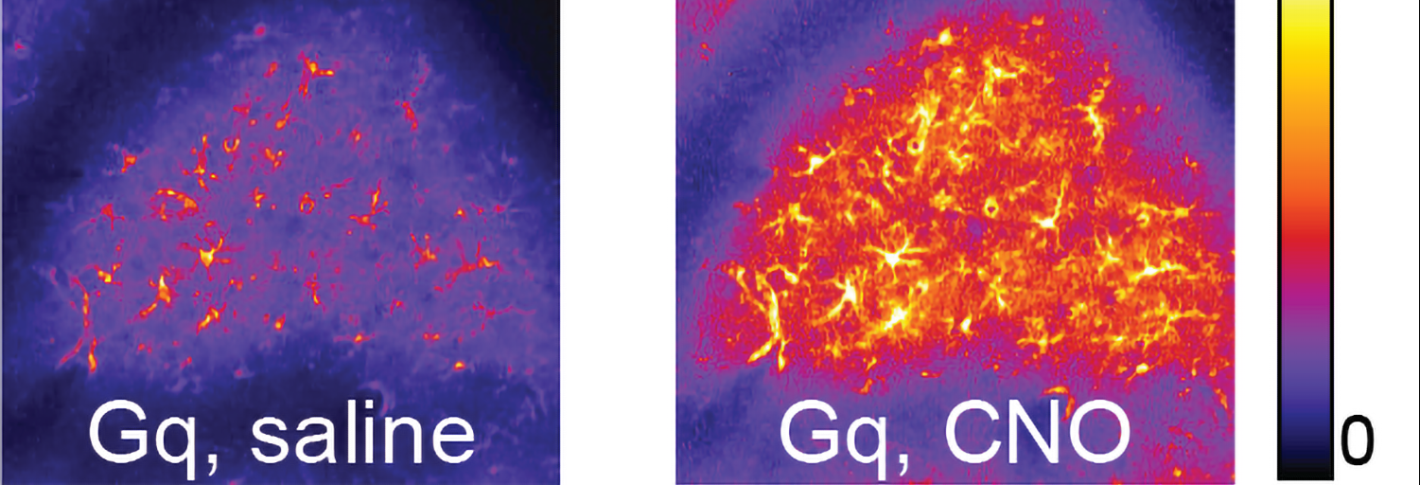Humans learn to handle a variety of skilled movements throughout their lives, from driving a car to swinging a tennis racket. Neurons are not the only ones who implement this learning, but a new study from The Picower Institute for Learning and Memory at MIT shows that astrocytes play an important role as well.
 Imaging based on calcium levels in astrocytes demonstrates the effect of the team's intervention to activate Gq signaling with a chemical called CNO. Cells lit up bright orange upon CNO application (right panel). Image Credit: Jennifer Shih.
Imaging based on calcium levels in astrocytes demonstrates the effect of the team's intervention to activate Gq signaling with a chemical called CNO. Cells lit up bright orange upon CNO application (right panel). Image Credit: Jennifer Shih.
According to the research, just as elite athletes train alongside coaching staff, ensembles of neurons in the brain’s motor cortex rely on nearby astrocytes to help them learn to encode when and how to move, as well as the optimal timing and trajectory of a motion. The recent research in the Journal of Neuroscience describes a series of experiments in mice and reveals two distinct ways that astrocytes directly affect neurons.
This finding is part of a body of work from our lab and other labs that elevate the importance of astrocytes to neuronal encoding and hence to behavior. This shows that while the population coding of behaviors is a neuronal function, we need to include astrocytes as partners with them.”
Mriganka Sur, Study Senior Author and Newton Professor, Neuroscience, The Picower Institute
Mriganka Sur is also a professor at MIT’s Department of Brain and Cognitive Sciences.
Picower Institute Postdoc Jennifer Shih and former Sur Lab postdocs Chloe Delepine and Keji Li are the paper’s co-lead authors.
“This research highlights the complexity of astrocytes and the importance of astrocyte-neuron interactions in fine-tuning brain function by providing concrete evidence of these mechanisms in the motor cortex,” Delepine said.
Messing with motor mastery
The mice were given a simple motor task to master by the group. The mice had 5 seconds after hearing a tone to reach for and push down a lever. The rodents demonstrated that they could understand the task in a few days and master it in a couple of weeks. They not only completed the task more precisely, but their reactions also became faster, and the trajectory of their reaching and pushing became smoother and more uniform.
However, in a few of the mice, the researchers used precision molecular interventions to hinder two distinct functions of astrocytes in the motor cortex. They interfered with the ability of astrocytes to absorb the neurotransmitter glutamate, a chemical that stimulates neural activity when it is received at synapses.
They hyperactivated the calcium signals of astrocytes in other mice, affecting how they functioned. Both interventions interrupted the normal process by which neurons form or change their connections with one another, a process known as “plasticity” that allows learning.
Each intervention influenced the mice’s performance. The first (a knockdown of the glutamate transporter GLT1) had no effect on whether the mice pushed the lever. Rather, it interrupted the motion’s smoothness. Mice lacking GLT1 stayed erratic and shaky, as if unable to fine-tune their technique.
Mice exposed to the second intervention (activation of Gq signaling) demonstrated deficits not only in the smoothness of their motion trajectory but also in their understanding of when to push the lever and their speed in doing so.
The group delved deeper into the causes of these deficiencies. They documented neural activity in the motor cortex of unaltered mice and mice treated with each intervention using a two-photon microscope. When compared to normal mice, the mice with GLT1 disruption showed less correlated activity among neurons. Mice with Gq activation had higher levels of correlated activity than normal mice.
The authors note, “The data suggest that an optimal level of neuronal correlation is required for the emergence of functional neuronal ensembles that drive task performance. Meaningful correlations that carry information are what drive motor learning rather than the absolute magnitude of potentially non-specific correlations.”
The group dug even deeper. They cautiously separated astrocytes from the motor cortex of mice, both untrained and trained in the motor task, and mice that were unaltered and mice that underwent each intervention.
Researchers sequenced RNA from all these purified astrocyte samples to see how they varied in gene expression. They discovered that in trained versus untrained mice, astrocytes expressed more genes related to GLT1. They observed decreased expression in mice where they intervened. This evidence also suggested that the glutamate transporter process is important for motor task training.
Here we show that astrocytes have an important role in enabling neurons to encode information properly, both the learning and the execution of a movement for example.”
Mriganka Sur, Study Senior Author and Newton Professor, Neuroscience, The Picower Institute